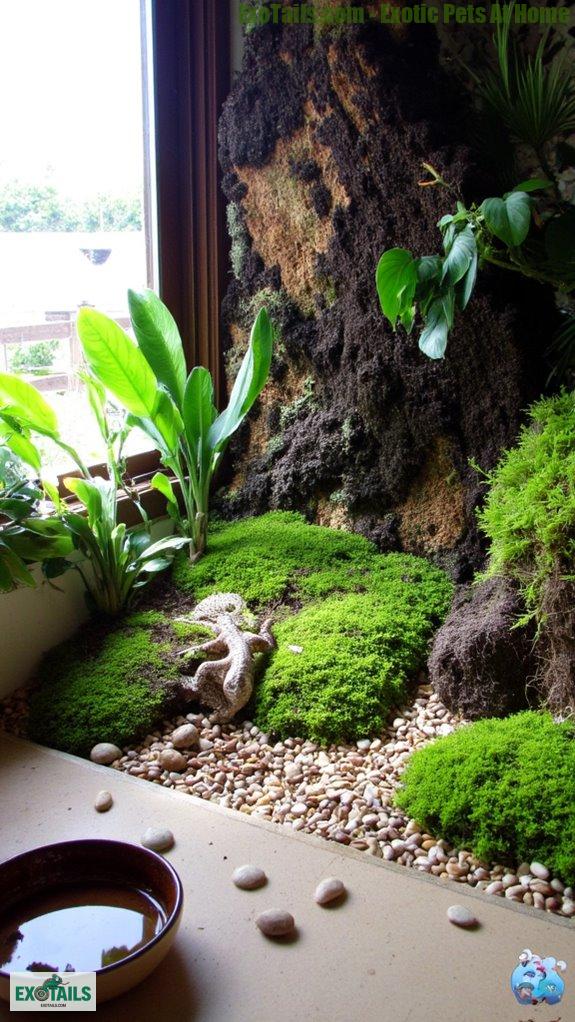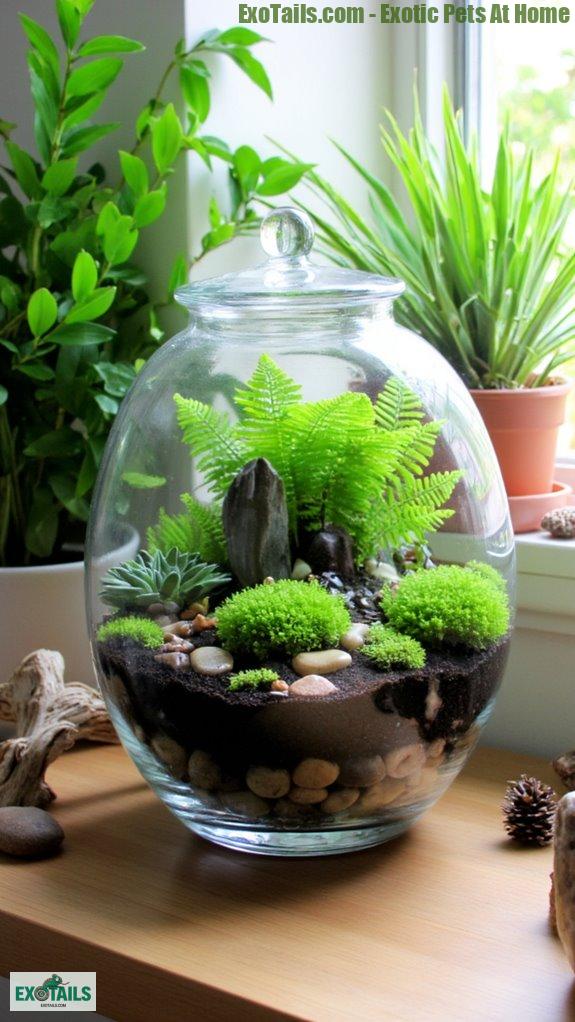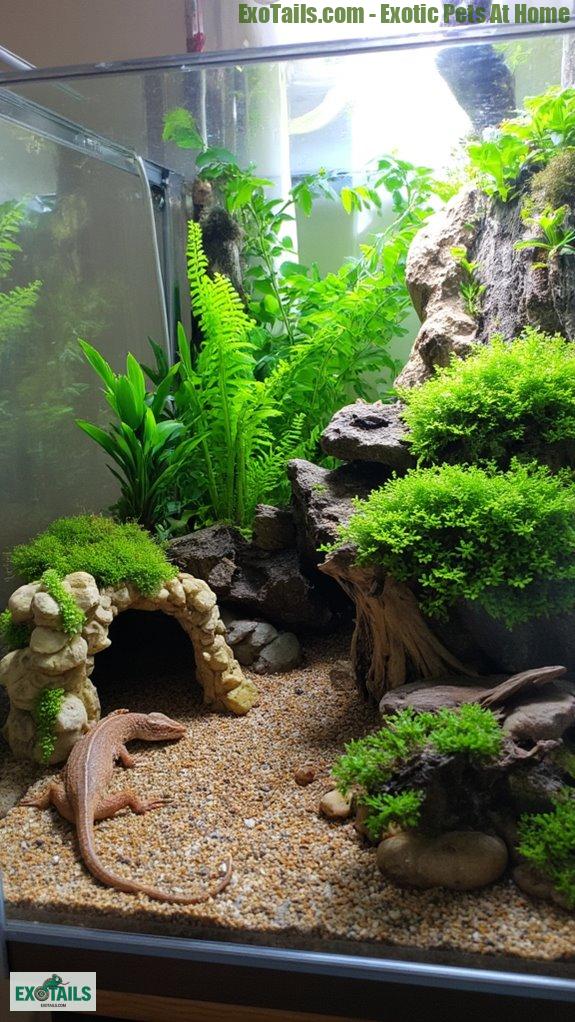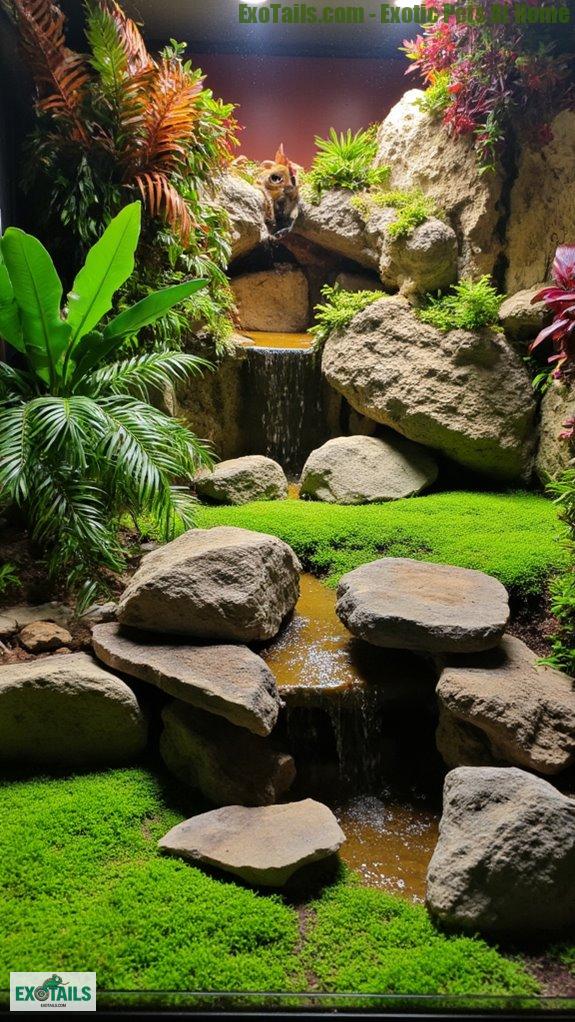Naturalistic Terrarium Backgrounds for Exotic Pets
Creating naturalistic terrarium backgrounds for your exotic pets is a fun way to mimic their wild homes! I love mixing durable materials, like cork bark and moss, to add depth and texture. Plus, incorporating live plants not only brightens up the space but also helps create a mini ecosystem. You’ll want to choose colors that uplift or calm. Trust me, a well-designed habitat makes all the difference in your pet’s happiness. Stick around, and I’ll share more exciting tips!
Quick Takeaways
- Choose durable materials like cork, moss, and stones to create a long-lasting and visually appealing backdrop for your exotic pet’s habitat.
- Utilize layering techniques with larger items in the back to enhance depth and create a three-dimensional effect.
- Integrate live plants that thrive in your pet’s environment to foster a vibrant and natural ecosystem.
- Select background colors and patterns that reflect your personal style while promoting your pet’s well-being and creating a calming atmosphere.
- Regular maintenance, including cleaning and quick repairs, is vital to keep the terrarium backdrop looking vibrant and promote your pet’s wellness.
Choosing the Right Materials for Naturalistic Backgrounds

When it comes to creating a naturalistic terrarium background, have you ever wondered what materials will make your mini-ecosystem come alive?
I’ve found that using materials with high durability sounds impressive, right? It guarantees your backdrop doesn’t crumble after a few months.
Texture variety is equally important; it gives depth and interest. Think about mixing cork bark with moss and stones for visual appeal. Trust me, it’s like a spa day for your critters!
Mixing cork bark, moss, and stones adds depth and visual appeal—your critters will feel like they’re in a luxurious spa retreat!
Since I started ExoTails to merge my passion for exotic pets and home decor, I can assure you: the right materials make all the difference in creating a stunning habitat! Additionally, incorporating natural elements will help mimic your pets’ natural environments, enhancing their overall well-being.
Techniques for Creating Depth and Texture

Creating depth and texture in your terrarium background isn’t just for show; it’s about crafting a miniature world that captivates both you and your pets!
I use layering techniques to build up the background, placing larger items at the back and smaller ones in front. This creates a stunning, three-dimensional effect.
For texture creation, mixing materials like cork, rocks, and bark gives visual interest. Ever seen a gecko lounge on a textured surface? It’s mesmerizing!
Incorporating naturalistic backgrounds enhances not only the aesthetics but also provides essential climbing surfaces for your pets. Trust me, your pets will appreciate the scenery, and you’ll secretly feel like the Picasso of mini pet worlds! What’s not to love?
Integrating Live Plant Life Into Your Terrarium

While it might seem intimidating, integrating live plant life into your terrarium transforms it from a basic setup into a vibrant ecosystem.
Trust me, the right plant selection is key. Choose plants that thrive in your environment, like ferns or mosses. Incorporating desert plants can also add unique aesthetics and function to the ecosystem.
Choosing the right plants, like ferns or mosses, is crucial for creating a thriving terrarium environment.
Then, don’t underestimate substrate layering; it’s your best friend! Aim for a mix of drainage and nutrient-rich layers.
Just think, you’ll create a little rainforest right in your home!
I love enjoying my exotic pets in a lively backdrop, and that’s why I created ExoTails to share this passion.
Selecting Suitable Background Colors and Patterns

Choosing the right colors and patterns for your terrarium background can make all the difference, and it’s a fun chance to express your style!
Think about color psychology: vibrant hues can lift spirits, while earthy tones feel calming.
Now, let’s talk pattern influence. Stripes may add height, while spots create a playful vibe.
Imagine how your exotic pet reacts to these choices.
I’ve always found joy in decorating, which led me to create ExoTails!
So, what background speaks to you? Let’s invigorate your space and make it your pet’s paradise.
After all, pet happiness reflects our own, right?
Maintenance Tips for Long-lasting Terrarium Backgrounds

To keep your terrarium background looking vibrant and fresh, it’s essential to give it a little TLC every now and then.
I mean, who wants a dull backdrop for their exotic buddies?
Regular background cleaning can prevent mold and stains. A damp cloth works wonders, and for stubborn spots, a mild soap solution is your best friend.
If you notice any chips or cracks, don’t panic! Simple repair techniques can make it good as new.
Trust me, your terrarium will thank you. I started ExoTails to help fellow enthusiasts like you create enchanting homes for our scaly or furry friends!
Enhancing Natural Behavior in Exotic Pets With Terrarium Design

Creating a terrarium that truly reflects the natural habitat of your exotic pet is like giving them an all-access pass to an adventure wonderland.
Imagine your pet exploring, climbing, and hiding—all in a setup that feels like home. Isn’t it thrilling to think your design offers behavioral enrichment? With rocks, plants, and textures mimicking their wild surroundings, you’re actively enhancing their lives.
I started ExoTails to share my love for exotic pets and home decor. It’s all about control, isn’t it? You can shape their world, making it feel lively and engaging.
Creating Cozy Animal Spaces

While it might seem simple to set up a cozy space for your delightful furry, scaly, or feathery friends, it’s actually an art that combines comfort, safety, and a touch of whimsy.
Creating cozy hideouts and offering plenty of animal enrichment can make all the difference in their happiness.
Here’s a quick guide:
| Cozy Hideouts | Animal Enrichment |
|---|---|
| Natural wood caves | Climbing branches |
| Soft moss beds | Foraging toys |
| Leafy plant cover | Interactive puzzles |
| Well-placed rocks | Hiding spots |
Buckle up, because your pets deserve nothing less!
Questions and Answers
What Exotic Pets Benefit Most From Naturalistic Terrarium Backgrounds?
I’ve found that various gecko species thrive with naturalistic terrarium backgrounds. These setups provide essential reptile enrichment, promoting their natural behaviors, helping you maintain a vibrant and active environment. It’s truly rewarding to see them flourish!
Can I Use Artificial Plants in My Naturalistic Terrarium?
Absolutely, I’ve found that using artificial plant types can enhance terrarium aesthetics. Just be sure to choose lifelike options that complement the natural decor, keeping your setup visually appealing while still maintaining control over upkeep.
How Often Should I Replace the Terrarium Background?
I know it might seem like a hassle, but I replace my terrarium background every 6-12 months for ideal terrarium maintenance. This guarantees background longevity and keeps my setup looking fresh and vibrant for everyone.
Are There Any Harmful Materials to Avoid in Terrarium Backgrounds?
When choosing background options, I avoid toxic materials like untreated wood, certain plastics, and chemicals that could leach. Prioritizing safety helps create a healthy environment for my pets, so I always double-check those materials.
How Can I Ensure Proper Humidity Levels With a Naturalistic Background?
Did you know that maintaining humidity levels above 50% can boost plant growth considerably? I monitor moisture through hygrometers, selecting background materials wisely to aid in humidity maintenance and create a thriving environment for my pets.






